Valencia Travel Guide
Valencia is often overlooked in favour of Madrid or Barcelona, but it's a heady blend of culture, golden beaches and gastronomic bliss. Architecturally intriguing in a way that eludes most European cities, this stylish destination is perfect for city breaks and leisurely days on balmy shores.
Ancient Romans founded Valencia in 137 BC, and it's been pillaged, burned and besieged many times by various conquerors since then. The vivacious city has nevertheless sailed into the second millennium as a sophisticated, modern holiday destination. A favoured location for the America's Cup yacht race, Valencia is situated on the Mediterranean coast about four hours south of Barcelona, and is spread out around its busy port.
A walk along the city's sun-kissed streets will reveal a dizzying wealth a architectural styles. These range from grand Gothic monuments and dramatic Renaissance chapels to lively Modernista markets, and the iconic, innovative works of Santiago Calatrava, who's widely recognised as one of the world's elite designers. He, together with Spanish-Mexican architect, Félix Candela Outeriño, designed the seemingly futuristic City of Arts and Sciences, which draws around four million appreciative visitors each year, and is Valencia's biggest attraction.
Valencia is backed by hills that give way to the plains of Aragon, and it oozes traditional character, particularly in its old town (El Carmen). Along with some arresting examples of medieval architecture, Valencia has retained its cultural heritage through its quirky, exuberant festivals such as the Battle of the Flowers, the fireworks of Fallas, and even one dedicated to tomato-hurling. Valencians have their own language as well.
Outdoors, it's hard to beat the yellow-sand shores that fan out from the port along the coast, and the sprawling city offers plenty of green parks for strolling, cycling, or simply lolling on a bench to get a breath back after indulging in the vibrant life of the city. Football is a local passion, and fans shouldn't miss the atmosphere at one of the carnival-like Valencia FC home matches, which are played at the Mestalla stadium. When night falls, travellers can dine on paella, which originated here, and then hit the town, as Valencia is renowned for its lively collection of bars and clubs.
Things to do in Valencia
A holiday in Valencia offers attractions to suit all tastes, from beautiful beaches right on the doorstep to a host of museums, art galleries, bars, restaurants and nightclubs, a full calendar of exciting festivals, and historic sites.
There are some wonderful beaches near Valencia, such as El Saler, El Puig, and Sagunto, which are all less than an hour out of the city. The beaches within the city are less glorious but still good for a swim and a suntan. Valencia has some lovely green lungs as well, including the Antiguo Cauce del Rio Turia park, and the Bioparc Valencia, which is a great zoo.
Historical attractions in Valencia include the ancient Crypt of Saint Vincente, which contains evidence of the city's Visigoth, Roman, and Muslim heritage; the UNESCO-listed Silk Exchange (Lonja de la Seda), founded in 1469; the Valencia Cathedral, which is said to be the final resting place of the Holy Grail; and the beautiful Palacio del Marques de Dos Aguas. A wander through the atmospheric El Carmen district is a must, as is a lazy meal or drink in the Plaza de la Virgen.
With a comprehensive bus and metro system, it's easy to get around Valencia while sightseeing. The metro system is not extensive, consisting of four lines, but covers the major points in the city, including a tramway to the beach. Buses, on the other hand, will get visitors to just about anywhere. More active visitors can opt to hire a bicycle, and enjoy Valencia's great network of cycle paths. Much of the city can also be explored on foot.
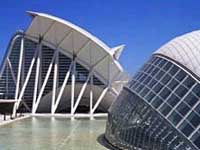
City of Arts and Science
The impressive, futuristic landscape of the City of Arts and Science covers a vast area, and rises out of a man-made lake in what was formerly the bed of the River Turia. It encompasses various attractions accessed along a magnificent arched walkway, which is overhung with an array of flowering aromatic plants and shrubs. The city consists of five areas: the Hemisferic, containing the IMAX cinema and other digital projections; the Umbracle, a landscaped viewing and parking area; the Principe Felipe Science Museum, dedicated to interactive science; the Oceanografico, the largest aquarium in Europe, housing more than 500 marine species; and the Palau de lest Arts Reina Sofia, which hosts opera, theatre, and music performances.
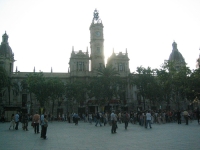
El Carmen
The ancient district of El Carmen sits in the heart of Valencia's old town, where there are narrow cobbled alleyways, honey-coloured buildings, and bars and cafes that make up a laid-back Bohemian atmosphere. El Carmen also has several interesting attractions, including the remains of the medieval city walls, and the Gothic tower gates of Torres de Serrano and Torres de Quart, the latter pocked with cannon-ball marks dating from an assault by Napoleon. Roman and Moorish influences are clear in the Old Town and the numerous squares and narrow streets give the area an authentic medieval feel, despite the invasion of tourists as the city increases in popularity. Along with several museums, there is also a convent complex dating back to the 13th century.
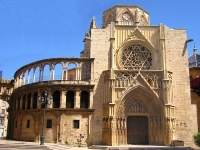
Valencia Cathedral
It is reputedly the resting place of the Holy Grail but, whether visitors believe that or not, the ornate Valencia Cathedral is worth a visit just because of its unique history and combination of architectural styles. Since it started out in 1262, it has shuffled back and forth from being a mosque to a Christian church, and has been added to accordingly in a variety of styles from Romanesque to Gothic, Baroque, and even Moorish. It houses an interesting museum, treasury, and the Holy Grail chapel. Visitors should also look out for paintings by Goya.
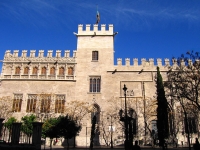
Silk Exchange (Lonja de la Seda)
One of Valencia's UNESCO World Heritage Sites is the old Silk Exchange, which was founded in 1469, and copied from a similar structure built in Palma de Mallorca. The walled tower and flamboyant Gothic trading hall, once used for the trade of precious items such as silk and gold, make what is widely regarded as the city's most beautiful building. It's now a top tourist attraction and is often used for hosting art exhibitions. The immensely high vaulted ceiling tops some unusual and very attractive pillars, the floors are lovely, and there is lots of intricate stonework and Gothic detail to admire.
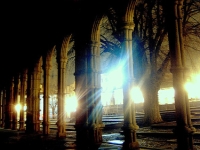
Crypt of Saint Vicente
The Crypt of San Vicente is an ancient part of Valencia and exploring the space takes visitors on an intriguing archaeological journey through the history of the city. The crypt has existed in many different incarnations: it was once part of a Visigoth chapel; was converted into palace baths during Muslim rule; and was incorporated into a Christian chapel dedicated to the martyr San Vicente (although it is unclear whether the saint was ever actually imprisoned here as some historians claim). There is even evidence of Roman architecture in the crypt, which is located in a district once occupied by Roman nobles. It is possible to wander in and see the ruins.
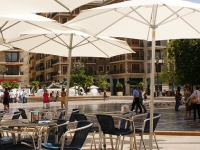
Plaza de la Virgen
The Plaza de la Virgen is one of Valencia's loveliest squares. Once the site of an ancient Roman forum, a fountain sits in the centre and is surrounded by plenty of open-air cafes. On one side of the square is the impressive Gothic façade of the Palau de la Generalitat, seat of government for the Valencia region, and opposite is the Baroque Basilica de Nuestra Senora de los Desamparados, a grand church dating from the 17th century containing fascinating frescoes. The Plaza de la Virgen is an entertainment hub during the famous Fallas Festival in Valencia, which sees the community building big, creative sculptures in the square and later burning them. Street performers come into the square during the evening.
Getting Around
The Metro Valencia has five lines that run to major points within the city, including a tramway to the beach, and the system runs from 5.30am to midnight. The city bus system has fairly comprehensive service within Valencia, running from 4.30am to 10.30pm, with additional night buses from 10.30pm to 2am (3.30am on Fridays).
Travellers should invest in the Valencia Tourist Card, which offers unlimited use of the bus and metro for one to three days, and can be purchased at hotels and tourist offices. Many people find that most of the city centre can be explored on foot, unless they plan to go to the beach. Taxis are the most convenient way to get around at night; they can be hailed on the street, found at taxi ranks, or phoned. Fares are metered, and rates should be clearly displayed. Uber is also an option.
Valencia Climate and Weather
Valencia has a Mediterranean climate with hot summers and mild winters, and an average annual temperature of 62°F (17°C). The peak summer months, between June and August, are hot and dry, with average temperatures in August, the hottest month, ranging between 70°F (21°C) and 85°F (29°C).
Summers are sometimes said to last from April to November. Winters, between December and February, are mild by European standards, with the average temperatures in January, the coldest month, ranging between 44°F (7°C) and 61°F (16°C).
It can rain in any season but the peak summer months tend to stay dry. Most of the rainy days occur during autumn and early spring, with October being the wettest month. Summers can be baking hot, and humidity tends to be high.
The most popular time for a holiday is during the hot summer months, when the streets buzz with visitors and activities of all sorts. With its warm climate, however, it's possible to visit Valencia at any time of year and be assured of some sunshine, and some people prefer to enjoy the city out of season when it is quieter, though never dull. March, during the famed Fallas Festival, is another good time to visit.
Spain travel info
Electricity
The electrical current is 230 volts, 50Hz. European-style two-pin plugs are standard.
Language
Spanish is the official language, but English is widely understood in areas frequented by tourists. Catalan, Galician and Basque are spoken in the relevant areas.
Money
Spain's official currency is the euro (EUR), which is divided into 100 cents. Money can be exchanged at bureaux de change and major hotels, but banks give the best rates. All major credit cards are widely accepted at most hotels, restaurants, and shops. ATMs are widespread and are generally the cheapest and most convenient method of obtaining money.
Tipping
Hotel and restaurant bills usually include service charges, but additional tips are welcomed for services rendered. In established restaurants, tips of about 10 percent are expected. Drivers of metered taxis expect small tips and it's customary to tip about 5 to 10 percent for most services, including guides.
Health
There are no health risks associated with travel to Spain, and no vaccination certificates are required for entry. Medical facilities are good but comprehensive travel insurance is always advised. Spain has a reciprocal health agreement with most EU countries that provides emergency health care for EU travellers on the same terms as Spanish nationals. After Brexit, the Global Health Insurance Card (GHIC) replaced the European Health Insurance Card (EHIC) for UK citizens. The GHIC allows UK citizens access to state healthcare during visits to the EU. The GHIC is not valid in Norway, Iceland, Liechtenstein or Switzerland, nor is it an alternative to travel insurance. EU travellers should take a European Health Insurance Card (EHIC). Travellers should take any medication they require along with them, in its original packaging and accompanied by a signed and dated letter from a doctor detailing what it is and why it is needed.
Safety
Most visits to Spain are trouble-free except for occasional street crime. Petty crime, such as pickpocketing and purse snatching, is most common in larger cities, particularly during holidays, festivals and weekends, and especially on public transport and in tourist areas. Thieves may work alone or in groups; visitors should be wary of strangers who offer or ask for help of any kind, or inform them of a stain on their clothes, as these are often ways of providing a distraction for accomplices. There are also scams involving letters for outstanding traffic fines or Spanish lottery winnings. Travellers can avoid incidents if they exercise all the normal precautions.
Local customs
Smoking in public places is banned and stiff fines will be imposed for smoking in areas such as enclosed public spaces, areas where food is prepared and sold, public transport, non-smoking areas of bars and restaurants, and any places that cater for children. Drinking alcohol in the streets of Madrid and the streets of the Canary and Balearic Islands is illegal.
Doing business
The business culture in Spain is slowly shifting but, for now, it's entrenched in tradition and it can take some time for foreigners to gain a foothold in the Spanish working world. It's important never to undermine authority as hierarchy is central to Spain's business world. Managers tend to make decisions without considering input from their colleagues.
A strong emphasis is placed on social status, character attributes, and personal pride. Success is often hinged upon being well-dressed, honourable, and dignified, while also exhibiting great social skills. Business meetings are generally conducted face-to-face and can go on for long periods, as Spaniards prefer long deliberations in order to avoid uncertainty in corporate dealings. Business meetings in Spain tend to tread a fine line between personal and formal.
Conducting business in Spain can entail navigation through a lot of red tape and bureaucracy. Spanish is the language of business, but some of the larger multinationals conduct meetings in both English and Spanish. Business hours are often quite varied, but generally open by 9am and close in the mid-evening with a two-hour lunch break during the early afternoon.
Business attire is quite conservative with men wearing dark or linen suits, shirts and silk ties. Women should wear modest dresses or tailored suits. Brand names or labels attract affirmation from colleagues and associates.
After the conclusion of successful negotiations, gifts are appropriate. Gifts should be of high quality and, when receiving a gift, it should be opened in front of the giver. Business cards are important and should be bilingual. Meetings are best scheduled for mid-morning, and establishing a formal yet personable environment is important before beginning. Meetings often occur over lunches and dinners.
Duty free
Travellers from EU countries are allowed the following items duty free: 800 cigarettes or 400 cigarillos or 200 cigars or 1kg tobacco; 110 litres beer; 90 litres wine; and 10 litres spirit. Travellers from non-EU countries may have 200 cigarettes or 100 cigarillos or 50 cigars or 250g tobacco; 1 litre spirits, 4 litres wine, and 16 litres beer.
Communications
The international access code for Spain is +34. WiFi is widely available; travellers can purchase local SIM cards for unlocked phones or use eSIMs if their cellular providers support it on their networks.
Passport & Visa
The borderless region known as the Schengen area includes the following countries: Austria, Belgium, Czech Republic, Denmark, Estonia, Finland, France, Germany, Greece, Hungary, Iceland, Italy, Latvia, Lithuania, Luxembourg, Malta, The Netherlands, Norway, Poland, Portugal, Slovakia, Slovenia, Spain, and Sweden. All these countries issue a standard Schengen visa that has a multiple entry option, allowing the holder to travel freely within the borders of all. Non-EU nationals must hold a return or onward ticket, all necessary documents for onward travel and sufficient funds. It is highly recommended that passports have at least six months' validity remaining after the intended date of departure from Spain. Immigration officials often apply different rules to those stated by travel agents and official sources.
Entry requirements
United States citizens require a passport valid for three months beyond the period of intended stay. No visa is required for stays of up to 90 days within a 180 day period.
British citizens require a passport valid for three months beyond the period of intended stay. No visa is required for stays of up to 90 days within a 180 day period.
Canadian citizens require a passport valid for at least three months beyond period of intended stay. No visa is required for stays of up to 90 days within a 180 day period.
Australian citizens require a passport valid for at least three months beyond period of intended stay. No visa is required for stays of up to 90 days within a 180 day period.
South African citizens require a passport valid for at least three months beyond period of intended stay. A visa is required.
Irish nationals require a valid passport, but a visa is not necessary.
New Zealand citizens require a passport valid for at least three months beyond period of intended stay. No visa is required for stays of up to 90 days within a 180 day period.
Useful contacts
Spanish Tourist Office, Madrid: www.spain.info.
112 (General).


